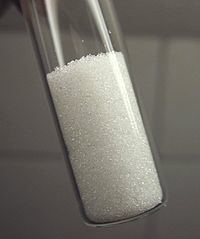Appearance white solid Molar mass 105.075 g/mol Density 2.5 g/cm³ | Formula BeSO4 Melting point 110 °C Boiling point 580 °C | |
 | ||
Beryllium sulfate normally encountered as the tetrahydrate, [Be(H2O)4]SO4 is a white crystalline solid. It was first isolated in 1815 by Jons Jakob Berzelius.
Beryllium sulfate may be prepared by treating an aqueous solution of any beryllium salt with sulfuric acid, followed by evaporation of the solution and crystallization. The hydrated product may be converted to anhydrous salt by heating at 400 °C. The tetrahydrate contains a tetrahedral Be(OH2)42+ unit and sulfate anions. The small size of the Be2+ cation determines the number of water molecules that can be coordinated. This contrasts with the analogous magnesium salt, MgSO4·6H2O which contains an octahedral Mg(OH2)62+ unit.
The anhydrous compound has a structure similar to that of berlinite. The structure contains alternating tetrahedrally coordinated Be and S and each oxygen is 2 coordinate (Be-O-S). The Be-O distance is 156 pm and the S-O distance is 150 pm.
A mixture of beryllium and radium sulfate was used as the neutron source in the discovery of nuclear fission.
